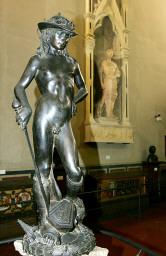The first major work of Renaissance sculpture, Donatello's bronze of David, is nearing the end of a complex restoration process.
The statue will be unveiled to the public during an inauguration ceremony on November 28 in Florence at the Bargello Museum.
The final phase of the 18-month restoration has seen the famed statue entirely closed off to visitors because of the sensitive tools being used.
Technological innovations have been used throughout the process, such as laser combs invented specially to swipe clean the delicate gold leaf that decorates parts of the work.
The 200,000-euro project followed a major check-up on the state of the work, carried out early in 2007. The David was subjected to X-rays and a range of other more sophisticated diagnostic tests.
Most experts believe Donatello (1386-1466) sculpted the sensuous work in the 1440s.
It depicts David standing with one foot on Goliath's severed head. Apart from a hat and a pair of boots, David is naked.
At the time of its creation, it was probably the first free standing bronze nude since ancient times and it caused a sensation.
The almost feminine physique contrasts with Michelangelo's powerful, masculine depiction of the biblical figure, sculpted between 1500 and 1504.
It is also very different from Donatello's earlier marble version - created around 1412 - in which David is clothed.
Donatello, whose full name was Donato di Niccolo' di Betto Bardi, was the son of a Florentine woolcomber.
As a teenager, he worked in the studio of noted sculptor Lorenzo Ghiberti.
Later, he travelled to Rome with the great architect Filippo Brunelleschi to study the monuments of antiquity.
Donatello's dramatic departure from stylised Gothic art is credited with kick-starting the Renaissance.
The Florentine sculptor even anticipated the use of perspective that is often thought a painterly invention - as can be seen in his early bas relief of St George and the Dragon on Florence's Orsanmichele church.
Other major Donatello works include a grim prophet called Habbakuk - or popularly, Zuccone (big head) - on Florence's Duomo and an equestrian warlord in Padua called the Gattamelata.





